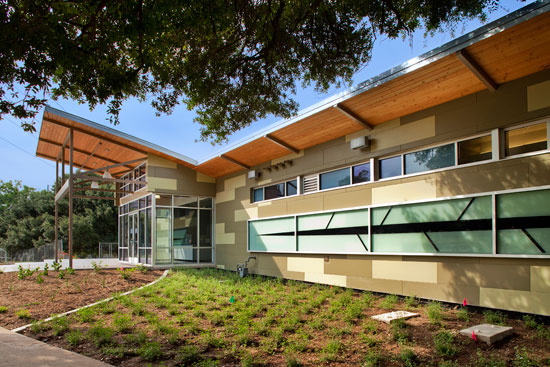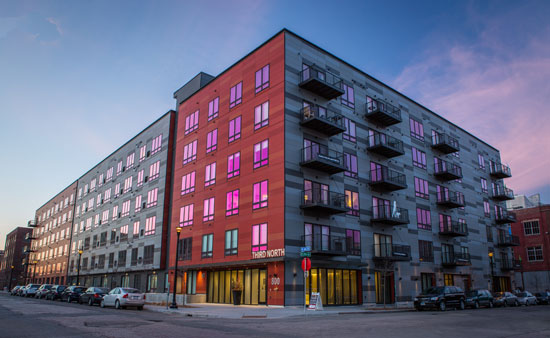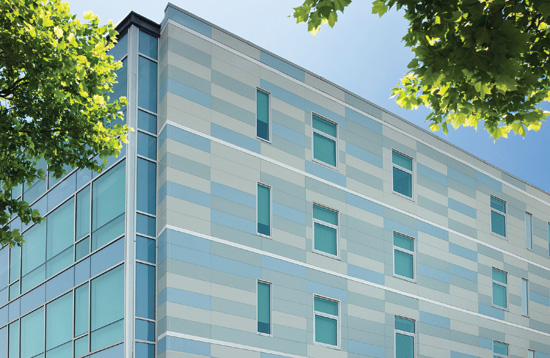Design Innovations Using Fiber Cement in Commercial Construction
Advanced commercial products affordably meet aesthetic design needs and wall performance requirements
![]() Continuing Education
Continuing Education
Use the following learning objectives to focus your study while reading this month’s Continuing Education article.
Learning Objectives - After reading this article, you will be able to:
- Identify and recognize the innovative characteristics of fiber cement products used in commercial buildings.
- Compare and contrast the differences between residential fiber cement siding and commercial fiber cement architectural wall panels.
- Assess the performance of commercial fiber cement products as they relate to code and testing requirements.
- Specify fiber cement products in a variety of building situations and make appropriate selections related to specific building types.
The design of commercial buildings requires that high performance becomes married with great aesthetics. Increasingly, both must be done while containing the material, labor, and installation costs of products used. One very visible and increasingly important area that has received a lot of attention in all of these regards is exterior cladding. While many different choices abound with varying degrees of weight, thickness, and ease of installation, one product has emerged as a very appealing solution in many cases. Architectural wall panels made from fiber cement have a proven history of allowing architects to create building exteriors that are innovative, affordable, sustainable, and able to create a variety of aesthetic design appearances.
Fiber Cement Products Overview
Fiber cement is, in simplest terms, a composite material that combines fibrous material with a portland cement binder to create a strong, dense product. It grew from a need to create a durable, lightweight, and affordable building product as an alternative to heavier and bulkier choices. In the early 1900s, some of the first products were developed in Europe combining paper-making technology with portland cement and asbestos. Its first application was for lightweight, fireproof roofing panels instead of the traditional terra cotta tiles common throughout Europe. In time, this technology produced siding panels and shingles that were introduced into the U.S. in the mid-20th century mostly for residential buildings. The growing concerns about asbestos, however, slowed their use until some alternatives were found. During the 1970s, fiber cement products were developed in Japan based on successes in manufacturing composite hardboard products without using asbestos-containing materials. These products and those created by other manufacturers have been offered in the U.S. for several decades and have become recognized as a safe, innovative, and even sustainable green building product.
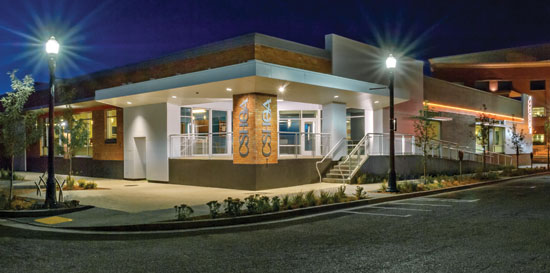
Fiber cement architectural wall panels are an advanced product compared to residential fiber cement siding and offer a full range of performance, aesthetic, and cost solutions.

Photos courtesy of Nichiha USA, Inc.
Fiber cement panels can be finished to be smooth or textured to provide an appearance of stone, wood, or other materials.
Manufacturing Process
Fiber cement products are currently created in a range of types, sizes, and styles. However, in all cases, the fundamental manufacturing process is similar and is based on combining several key ingredients:
▶ Wood fiber sources: Wood chips, raw wood fibers, and other wood products taken from recycled and virgin sources. The organic nature of the wood fibers provides a degree of resiliency and flexibility for the finished products, making them less brittle than some of their historical predecessors.
▶ Portland cement: Acting as the binder to the wood fiber, portland cement works the same way it does in masonry applications by creating a tight, secure bond within the finished product. Typically comprised of limestone, clay, and iron, it brings the inherent strength and rigidity of those elements as well.
▶ Silica filler: An inert filler is often desirable to use in order to reduce weight or contribute other characteristics. In certain fiber cement products, this filler is silica which is essentially just a technical term for sand which is among the most abundant materials on earth. It does not pose any health or environmental concerns unless it becomes airborne which may happen during installation when products might be cut and create dust. In those cases it can be an irritant to eyes and the respiration system while long-term exposure can cause other health concerns.
▶ Alternative fly ash filler: Although it's nearly impossible to eliminate, some fiber cement products contain extremely low levels of silica by using fly ash as an alternative inert filler material. Fly ash is a by-product of burning coal in electric power plants to produce electricity with about 5-10 percent of the coal left behind as fly ash. Since it is an extremely fine, lightweight powder, fly ash is captured in filters before it can escape into the air. According to the American Coal Ash Association, the majority (55 percent) of the 72 million tons of fly ash produced annually is disposed of, typically in landfills, though older plants can use surface ponds, which can create significant disposal issues. In some cases, there have been environmental problems with disposal in facilities not practicing best management techniques. This has caused the U.S. Environmental Protection Agency (EPA) to consider regulating fly ash disposal, to allow for a national guideline rather than the current, non-uniform regulation that occurs at the state level. The remaining 45 percent of fly ash is currently diverted from landfills through beneficial reuse (recycling) in a variety of applications, including fiber cement products. Recycling fly ash currently remains free of regulation, and, in fact, is encouraged by many organizations with different stakeholders. The U.S. EPA, the Natural Resources Defense Council (NRDC), and the U.S. Green Building Council have all agreed that recycling fly ash in building materials and products is beneficial and environmentally desirable. Hence, the EPA and leading environmental groups would like to see this beneficial reuse grow. Fiber cement manufacturers are helping with that beneficial growth while also finding that it improves the overall performance of the end products.
▶ Water: Depending on the manufacturing process, some water may need to be added to the other ingredients to activate the bonding effect. Certain formulations may simply use moisture already present in the other ingredients giving rise to the term “dry system”. Either way, the amount of moisture is measured and controlled to assure that the desired outcome is achieved.
Once the ingredients are proportioned and combined, the resulting material is processed into the desired shape and length. In some cases, stamping processes or molds are used to create the appearance of wood grain, stone, brick, or other patterns. Once the final size is shaped and pattern added, the final step is to apply protective coatings over the fiber cement products. These coatings are either prime coats for field finishing, or factory finish coats for a completely finished panel.
While the fundamental ingredients and processes are the same or similar, there are two distinct categories of fiber cement products—residential and commercial. The two should not be confused since they are fundamentally designed and produced to address different needs, different construction processes, and different aesthetics.
Residential Products
Residential products are essentially an intelligent replacement for traditional wood siding or board products. They are typically applied in a direct nailed manner just like other traditional residential siding products. As such, they require only basic carpentry skills to install without any additional training or special skills. Further, while some fiber cement products are pre-painted, it is more common to find them unfinished ready for standard painting or staining in the field. While this allows for competitive labor prices, it should be noted that the finish warranty is limited to the factory priming or pre-treatment.
From a building enclosure standpoint, residential fiber cement products are durable and often an excellent choice for residential applications. However, keep in mind that they rely on traditional residential water shedding, flashing, and moisture management to create a weathering system for the building. There is no commercial grade moisture management system inherent in these residential products. That means that there is no added cost for materials or specialty labor, but it does mean that careful attention to detail needs to be exercised to achieve a properly constructed assembly.
Commercial Building Products
Commercial fiber cement products are best described as architectural wall panels. They are much more suited to the more rigorous and demanding conditions of commercial buildings, particularly related to wind and weather conditions on multi-story buildings. Recognizing the need for higher performance, manufacturers offer not just the fiber cement panels, but also fully engineered installation systems. Key to the performance of commercial fiber cement products is the proper treatment of the exterior wall underneath including appropriate moisture and air flow management. The installation systems are designed to work with and complement both the integrity of the substrate wall construction and the durability of the architectural wall panels.
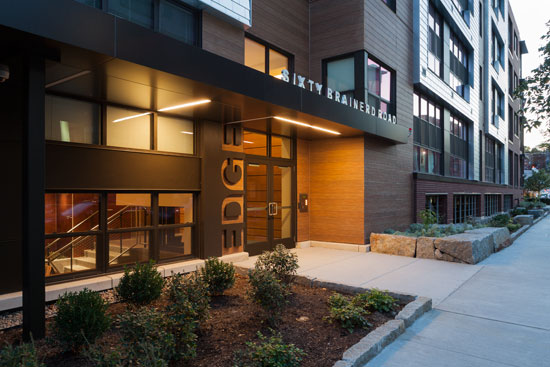
Photo courtesy of Nichiha USA, Inc.
Commercial exterior facades that need a strong aesthetic, high performance, and good cost effectiveness all benefit from fiber cement architectural wall panels.
Commercial fiber cement products are commonly fully pre-finished in a range of standard or custom colors and textures with a corresponding warranty on the total finish. For improved appearances, some manufacturers use hidden fasteners to create a clean, uncluttered look desired in many commercial buildings. When these appearance conditions are combined with the engineered installation system, commercial grade fiber cement architectural wall panels become an integral part of a high performance, durable, commercial exterior wall system.
Design Considerations
In choosing to use fiber cement architectural wall panels, there are a number of wall assembly design considerations to take into account. Some of these considerations are common to all assemblies while others will be specific to a particular design approach and solution. Several of these are discussed as follows.
Substrate Design
In all cases, commercial architectural wall panels made of fiber cement are designed to be installed over an appropriately designed exterior substrate. Since the panels and the substrate need to work together to create the weather resistance of the wall system, attention needs to be paid to such things as air barriers, vapor barriers & weather resistive/water resistive barriers. These items are common in many types of wall assemblies and are necessary elements in assemblies using fiber cement architectural wall panels as well. In all cases, a water resistive barrier (WRB) is required when installing fiber cement architectural wall panels. In some cases the WRB may also serve as an air barrier, otherwise that function will need to be addressed with a separate layer. Depending on the climate of the building location, an interior or exterior vapor barrier will also be required. Of course, all openings must have the appropriate flashing to prevent moisture penetration.
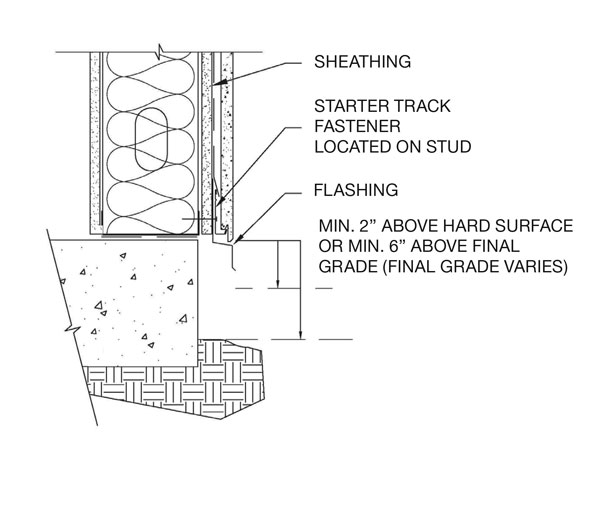
Image courtesy of Nichiha USA, Inc.
The design and make up of the wall behind the architectural wall panels needs to address proper air, water, and vapor barrier design using a variety of common building products commercially available.
When designing the make-up of the wall assembly there are a number of choices that can be selected from and considered. Traditional sheet goods or building wraps are common for both residential and commercial construction and rely on paper or fabric materials that are bonded or fused with chemicals or other compounds. In essence, they are installed to seal the entire structure and create a barrier, most commonly for air infiltration control. These sheet goods are stapled or otherwise fastened to exterior sheathing with attention needed to joints and overlapping edges, etc. to create a full and complete barrier, albeit with some compromises made at the fastener penetrations. By contrast, self-adhering sheet goods avoid the need for fasteners. These air and water barriers use multi-laminated layers or fibrous materials bonded together to form a large roll or sheet all backed with an adhesive and easy-release protective film. The sheathing needs to be clean and ready to receive these adhesive backed goods and care needs to be exercised so they are installed cleanly and without unwanted bubbles or other irregularities. The most continuous and seamless form of an air and water resistant barrier is a fluid applied type that is available in spray, trowel and roll on formulations. In this case, all areas are continuously treated, but wall joints can be given appropriate special attention to be well sealed and reinforced at panel joints & sill areas.
Panel Joint Types
Manufacturers of fiber cement architectural wall panels offer two fundamental choices in the types of panel joints and systems available, although different manufacturers may or may not offer both. The basic choice is between open joint assemblies as compared to closed jointed assemblies. Each type is discussed and compared as follows:
▶ Open joint systems. This type of system is used to create a ventilated, rainscreen type of exterior cladding system. These types of systems emerged from product needs to hold metal or fiber cement wall materials away from the substrate and literally provide a permeable screen against rain and other weather. As such, the water and air barriers over the sheathing are critical elements since they are the true exterior skin barriers and require significant attention to detail to function properly. When properly designed, open joint systems allow for air and water to both penetrate and drain out from behind the panels and away from the rest of the wall assembly. As such, they are fully ventilated between the panels and the substrate. Naturally, that means they require the space to perform this function meaning that some additional depth is needed in the wall assembly.
There are a number of details that need to be properly addressed when using open joint systems. The most basic is that the panels are commonly installed on a system of metal hat and J-channels to hold them off of the substrate and the weather barrier. This is where the additional wall assembly depth comes into play but it also means that the weather barrier is penetrated by the fasteners to hold the metal channels in place.
The barrier should be self-sealing therefore and due to the open joints, also needs to be UV stabilized since it is partly exposed. Installing the architectural wall panels to the metal channels usually involves a series of slipping points instead of fixed points to allow for proper adjustment and for expansion and contraction. When it comes to corners, the panels need to be detailed to come together or express a corner joint using the appropriate metal channels and maintain the proper alignment across two adjoining facades. In some cases, the joints can be filled or closed with materials suited to a particular manufacturer's system but the rainscreen function is likely still meant to be kept. And when it comes to panel sizes, commercial architectural wall panels are available in standard or custom sizes that may minimize the amount of field modification or cutting that is needed. If they are field modified, however, the edges of the panels will need to be field finished to protect the integrity of the panel.
▶ Closed joint systems. This type of system lives up to its name by eliminating the open joints between panels and instead creating a smooth, continuous surface on the exterior. This more closely resembles metal or composite exterior wall panels that are often used to achieve the same fairly continuous effect. Fiber cement panels are generally less expensive and easier to install than metal panels in many cases, however.

Image courtesy of Nichiha USA, Inc.
Closed joint systems rely on tight fitting shiplap panels that are held in place with low-profile clips instead of hat channels.
Closed joint systems are inherently simpler to design and install than open joint systems. Since the closed joints are designed not to allow bulk water to penetrate into the cavity, the space between the cladding and the substrate can be greatly reduced. The panels still function as a drained and back ventilated rainscreen but just in a much smaller depth. This also means that the attachment of the panels in closed joint systems do not require metal channels, but instead usually rely on a concealed, narrow, clip system spaced at appropriate intervals. The clips use less material and require less time for installation, all of which translates to less cost.
The actual panel joints are often factory formed to lap or join fairly tightly, sometimes with the addition of factory applied foam gaskets along the edges that helps seal the joints once installed. All of this means that the substrate barriers are not exposed and can be selected from more options, particularly without the concern for UV exposure. When it comes to corners, the panels can fit tightly or be butt joined to continue the appearance across adjoining facades. Of course, just like most building materials, long facades will require expansion joints to be designed in that relate to the expansion and control joint mechanisms for the building. Closed joint systems can be modified in the field just like open joint systems but proper planning and coordination with available manufactured sizes can minimize that. Any field modifications will need to address the edges of the panels to be sure the proper fit is maintained.
Panel Design Options
When working with fiber cement architectural wall panels, there are some significant design options that can be selected and worked with. The most fundamental is the size of the architectural wall panels which will vary by manufacturer. The height and length of the panels can range from smaller easy to handle sizes up to large format sizes. It is possible to work with a manufacturer to have multiple sizes on a single project and thus meet the design needs while minimizing the need for any field modifications. Consultation with manufacturers during the design phase can help with identifying the best sizing options and final selections for a specific project.
The other significant design option with fiber cement is the texture and finish of the wall panels. Smooth surfaces are available that emulate the contemporary sleek look of other materials such as metals. For other situations, a wood textured look may be desirable and is readily available as well. All are offered in a range of standard and custom colors to suit design needs and it is becoming common to see mixed colors intentionally used on a particular façade. Some manufacturers also offer brick and stone textures in appropriately matched colors to allow for a façade solution that comprises less weight and less than depth than traditional stone or masonry construction.
Testing and Performance of Fiber Cement Architectural Wall Panels
Like most manufactured building products, there are a number of relevant and useful tests that fiber cement architectural wall panels are subjected to in order to demonstrate their capabilities to perform in commercial settings. However, the issue is that many of these tests are designed primarily for other types of wall assemblies and have limited usefulness on rainscreen systems. Some of the commonly referred to tests are summarized as follows.
ASTM E283 Standard Test Method for Determining Rate of Air Leakage
This test method covers a standard laboratory procedure for determining the air leakage rates of exterior windows, curtain walls, and doors under specified differential pressure conditions across a sample or specimen product. The method calls for constant temperature and humidity across the specimen and is intended to measure only such leakage associated with the assembly sample and not the field installation. This test is often referenced for rainscreen type of walls, but the reality is that the cavity depth can alter the results and may not report readily comparable results between different systems.
ASTM E330 Standard Test Method for Structural Performance by Uniform Static Air Pressure Difference
This test method describes the determination of the structural performance of exterior windows, doors, skylights, and curtain walls under uniform static air pressure differences, using a test chamber. This test method is applicable to curtain wall assemblies and is a standard procedure for determining structural performance under uniform static air pressure difference. This typically is intended to represent the effects of a wind load on exterior building surface elements. However, the actual loading on building surfaces is quite complex, varying with wind direction, time, height above ground, building shape, terrain, surrounding structures, and other factors. This test method is intended only for evaluating the structural performance associated with the specified test specimen and not the structural performance of adjacent construction. As such, it is useful but not necessarily completely applicable or accurate when looking at rainscreen architectural wall panels.
ASTM E331 Standard Test Method for Water Penetration of Exterior Windows, Skylights, Doors, and Curtain Walls by Uniform Static Air Pressure Difference
This test method is a testing standard that describes the procedures to determine the water penetration resistance of windows, curtain walls, skylights, and doors when water is applied using a calibrated spray apparatus while simultaneously applying uniform static pressure to opposite sides of the test specimen. The testing is performed by applying water to the exterior of the test specimen while lowering the pressure inside by means of an air chamber built on the inside of the test specimen. The water spray system has nozzles spaced on a grid to deliver water in such a manner as to wet all of the test specimen uniformly, wetting those areas vulnerable to water penetration. The calibrated spray apparatus delivers water to the test specimen at a rate of 5.0 gal/ft²-h at a minimum testing pressure of 6.24 psf. It is attempting to replicate the condition of wind driven rain on a building surface. Although intended more for fenestration than for opaque wall surfaces, it can be useful to determine if the wall assembly behind architectural wall panels is resistant to water penetration.
AAMA 501.1 Standard Test Method for Water Penetration of Windows, Curtain Walls and Doors Using Dynamic Pressure
Similar to the ASTM test above, this standard test developed by The American Architectural Manufacturers Association (AAMA) establishes the equipment, procedures and requirements for optional laboratory testing of exterior windows, curtain wall and door systems for water penetration. However this test is based on using dynamic pressure instead of static pressure to see the range of performance. As such, this is not a “pass/fail” type of test as many are, rather it is intended to show performance at different pressures. It is also intended to simulate real world conditions of wind driven rain against a building.
AAMA 509-9 Voluntary Test and Classification Method of Drained and Back Ventilated Rain Screen Wall Cladding Systems
As we have seen, most of tests discussed so far were designed for some other purposes such as water and air penetration through the supporting back up wall or through fenestration systems. In response, AAMA recognized the need to develop testing that was specific to rainscreen wall cladding systems, such as fiber cement wall panels. Hence, AAMA 509-9 was developed for the primary purpose of quantifying the volume of rain water contacting an imperfect Air and Water Barrier (AWB) and the system's ability to allow for ventilation/drying as measured by air flow through the system. It is understood that water will reach the AWB which is both acceptable and anticipated. The question is how much water and whether the system is capable of allowing for subsequent drainage and drying. Under this test, there are four (4) essential design requirements that must be demonstrated:
▶ Water entry must be prevented from penetrating into or through the entire wall system (i.e. penetrating the AWB)
▶ The AWB shall be designed to provide the primary weather protection
▶ The wall system shall be designed to manage and drain any water entering the cavity behind the cladding. It shall also be sufficiently vented to allow the cavity to dry
▶ In the event that water vapor diffuses through the wall and AWB from the building interior and ultimately into the wall panel cavity, that water vapor shall be permitted to be vented and/or drained out to the exterior.
NFPA 285 Standard Fire Test Method for Evaluation of Fire Propagation Characteristics of Exterior Non-Load-Bearing Wall Assemblies Containing Combustible Components
This standard provides a standardized fire test procedure for evaluating the suitability of exterior, non-load bearing wall assemblies and panels used as components of curtain wall assemblies that are constructed using combustible materials or that incorporate combustible components for installation on buildings where the exterior walls are required to be non-combustible. Generally speaking most fiber cement products are not rated as combustible, however portions of the rest of the wall assembly might be, such as foam insulation products. The importance of this fire safety standard is that it does not test individual materials, rather it tests full assemblies. Further, it is referenced in the International Building Code as the standard to show code compliance for non-combustible exterior walls. Therefore, while the fiber cement wall panels can contribute to better compliance, the specific wall assembly as designed will need to show that it has been tested and passed this standard fire test method.
Specifying Fiber Cement Architectural Wall Panels Guidelines
In light of all of the above, there are a number of things to be cognizant of when specifying fiber cement architectural wall panels for commercial buildings. First, it is always recommended that manufacturers are contacted during the design process to determine specific capabilities, options, and system coordination items while they can be readily addressed. This is particularly important for taller buildings subject to greater weathering stresses and specific installation requirements. Once a specific type or types of fiber cement panels are decided upon, it will be appropriate to request manufacturer samples and submittals including product lead times to be sure that construction schedules are being met. It is then important to identify the appropriate testing requirements that should be asked for such as AAMA 509-9. Other testing requirements should be specific to the type of rainscreen or other wall system envisioned.
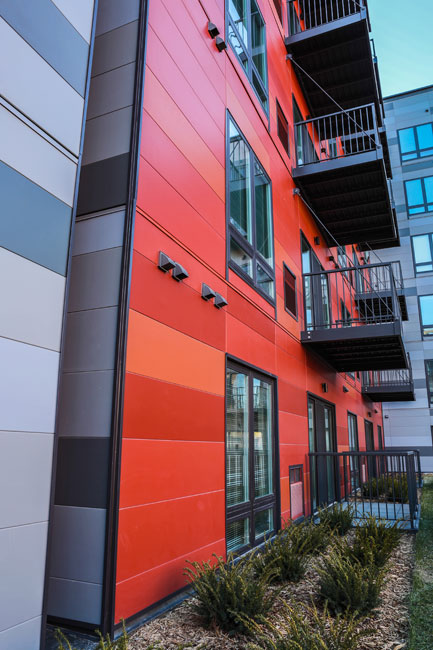
Photo courtesy of Nichiha USA, Inc.
Custom or standard colors can be specified for fiber cement architectural wall panels to suit a particular building design.
In terms of the particular products, all of the options and details will need to be listed. This will include the details of the panels such as size, color, and texture, but also the details and requirements for the installation system. If an open joint system is called for, then the channel system will need to be called out in detail and indicated on the drawings. If a closed joint system is preferred, then the clip installation system can be specified as part of the manufacturer's standard installation system. Other third party components or wall system requirements such as sealants, flashings, trims, and fasteners should all be called out as well and will need to be verified as compatible with the selected fiber cement panel products.
When it comes to installation, each manufacturer will have particular requirements especially since the installation system is likely made by them along with the panels. Those requirements should be consulted and referenced to be sure that the installation is done correctly and the integrity of the substrate wall is maintained. Although not all manufacturers provide training for installers, manufacturer trained installers are generally preferred as a matter of construction quality control.
Conclusion
Fiber cement architectural wall panels have been demonstrated as a proven wall cladding system for commercial buildings. They have been developed from a history of other successful building products and include ingredients that are readily available and abundant. Commercial products are designed differently than residential products to meet the demands and rigors of commercial installations. They are available in a variety of system types that allow for variation and choices in appearance, performance and wall assembly details. As a rainscreen product they can meet a range of tests in conjunction with a properly designed substrate or supporting construction wall. They are a worthy choice for consideration on current and future building projects where aesthetics, quality, and cost-effectiveness are needed.
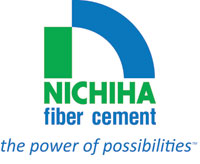 |
Nichiha USA, Inc. is a leading manufacturer of fiber cement siding and architectural wall panels for use in residential and commercial applications. Headquartered in Georgia since 1998, Nichiha has a 300,000-square-foot, state-of-the-art manufacturing facility in Macon, Georgia, that opened in 2007 to enhance the supply to the North American market. Nichiha invites you to explore the power of possibilities by calling 866.424.4421 or visiting www.nichiha.com. |

